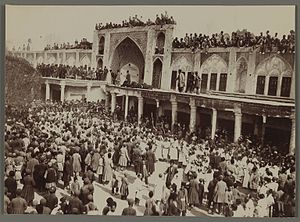Tatbir
Tatbir (Arabic: تطبير, romanized: Taṭbīr) is a form of self-flagellation rituals practiced by some Shia Muslims in commemoration of the killing of Husayn ibn Ali and his partisans in the Battle of Karbala by forces of the second Umayyad caliph Yazid I (r. 680–683).
The practice of Tatbir includes striking oneself with a talwar, a type of sword, on the head, causing blood to flow in remembrance of the pain felt by Husayn ibn Ali.
[5] Most religious authorities associate all forms of self-flagellation and blood-letting as ways to relate to painful deaths during the battle of Karbala by Imam Husayn and supporters.
"[16] "Religious rituals that Shias perform to mourn the tragedies of the Imams of the Ahlulbait (peace be upon them) and to present the oppressions that they suffered are recommended.
[26] "The inclusion of the aforementioned (acts like tatbir) under the category of recommended grief for what occurred to the Master of Martyrs is problematic/doubtful.


